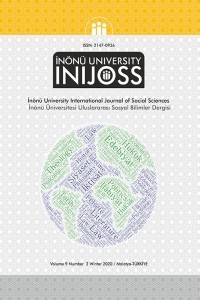İÇİMİZDEKİ CANAVARI EHLİLEŞTİRMEK: STEPHEN CRANE’NİN “CANAVAR” ADLI KISA ROMANININ EMPATİK BİR İNCELEMESİ
Oldukça yeni bir araştırma alanı olan anlatımsal empati, anlatıların okuyucularda empati duygusunu teşvik etme ve geliştirmede oynadığı rolü incelemektedir. Etik ve etik eleştiri tartışmalarıyla gündeme gelen anlatımsal empati, hem etik-edebiyat arasındaki ilişkiye dair daha önce yapılmış olan çalışmaların kapsamını genişletmek hem de evrensel bir duygu olarak karşımıza çıkan ve bize insanlığımızı hatırlatan empatiyi merkeze alarak bu çalışmalara değerli bir katkı sağlamak açısından büyük önem taşımaktadır. Anlatımsal empati teorisinin ileri sürdüğü gibi, acı içinde olan veya zor şartlar altında yaşayan kişilerle empati kurabilmek için onların acılarına ilk elden tanık olmak gibi bir zorunluluk bulunmamaktadır. Kurgusal veya kurgusal olmayan bu karakterler hakkında okuyarak bile, yazar tarafından yapılmış olan tematik ve formal seçimler sayesinde okuyucular bu karakterlerle empati kurabilirler. Ancak, sadece hukuk ve ekonomi alanlarında uzmanlaşmakla kalmayıp aynı zamanda ahlak felsefesi ve etik eleştiri ile ilgili eserler kaleme almış olan ve etkili bir şahsiyet olarak kabul edilen Richard Posner gibi bazı bilim insanları, etik ve estetiğin iki zıt kutup olduğu görüşündedirler, ve bu yüzden de edebiyatın okuyucuları empati kurmaya sevk etme potansiyeline karşı çıkmaktadırlar. Bu makale, Stephen Crane’nin ünlü kısa romanı “Canavar”da kullandığı belirli anlatı araçlarını ve tekniklerini inceleyip analiz ederek, etik ve estetik arasındaki ayrılmaz bağlantıyı ve Crane’nin bu stratejik tercihlerinin okuyucularda empati gelişimine nasıl katkıda bulunduğunu ortaya koymayı amaçlamaktadır.
TAMING THE MONSTER WITHIN US: AN EMPATHETIC READING OF STEPHEN CRANE’S “THE MONSTER”
Being a relatively new research interest, narrative empathy explores the role that narratives play in cultivating and stimulating empathy in readers. Coming into the picture upon the discussions on ethics and ethical criticism, narrative empathy is of capital importance in both expanding the scope of previous studies conducted regarding the relationship between ethics and literature, and in making a valuable contribution to these studies by centering upon a universal feeling that is evocative of our humanness, namely empathy. As suggested by the narrative empathy theory, to be able to empathize with others who are in pain or live under hard circumstances, it is not a necessity to witness their sufferings at firsthand. Even by reading about these fictional or non- fictional characters, readers can feel an empathy with them thanks to the authorial choice. However, some scholars like Richard Posner, who is regarded as an influential figure not only specializing in the fields of law and economics but also penning works related to moral philosophy and ethical criticism, are of the opinion that ethics and aesthetics are two opposite poles and that’s why argue against the potential of literature to lead readers to develop empathy. By exploring and analyzing the certain narrative devices and techniques employed by Stephen Crane in his acclaimed novella “The Monster”, this paper aims to demonstrate the inextricable connection between ethics and aesthetics, and how these strategic choices of Crane contribute to the cultivation of empathy in readers.
___
- Bachelard, Gaston. (1964). The Psychoanalysis of Fire. Routledge.
Bal, Mieke. (1997). Narratology: Introduction to the Theory of Narrative. University of Toronto Press.
- Booth, Wayne C. (1998). Why Ethical Criticism Can Never Be Simple. Style, 32 (2), pp. 351-364.
- Booth, Wayne C. (1989). The Company We Keep: An Ethics of Fiction. University of California Press.
- Crane, Stephen. (2000). The Monster. Phyllis Frus and Stanley Corkin (Ed.), “The Monster”, “The Upturned Face”, “The Red Badge of Courage”, “Maggie: A Girl of the Streets”, and Other Selected Writings (pp. 381-428.). Houghton Mifflin.
- Keen, Suzanne. (2006). A Theory of Narrative Empathy. Narrative, 14 (3), pp. 207-236.
- Lindhé, Anna. (2016). The Paradox of Narrative Empathy and the Form of the Novel, or What George Eliot Knew. Studies in the Novel, 48(1), pp. 19-42.
- Nussbaum, Martha. (1998). Exactly and Responsibly: A Defense of Ethical Criticism. Philosophy and Literature, 22(2), pp. 343-365.
- Posner, Richard. (1998). Against Ethical Criticism: Part Two. Philosophy and Literature, 22(2), pp. 394-412.
